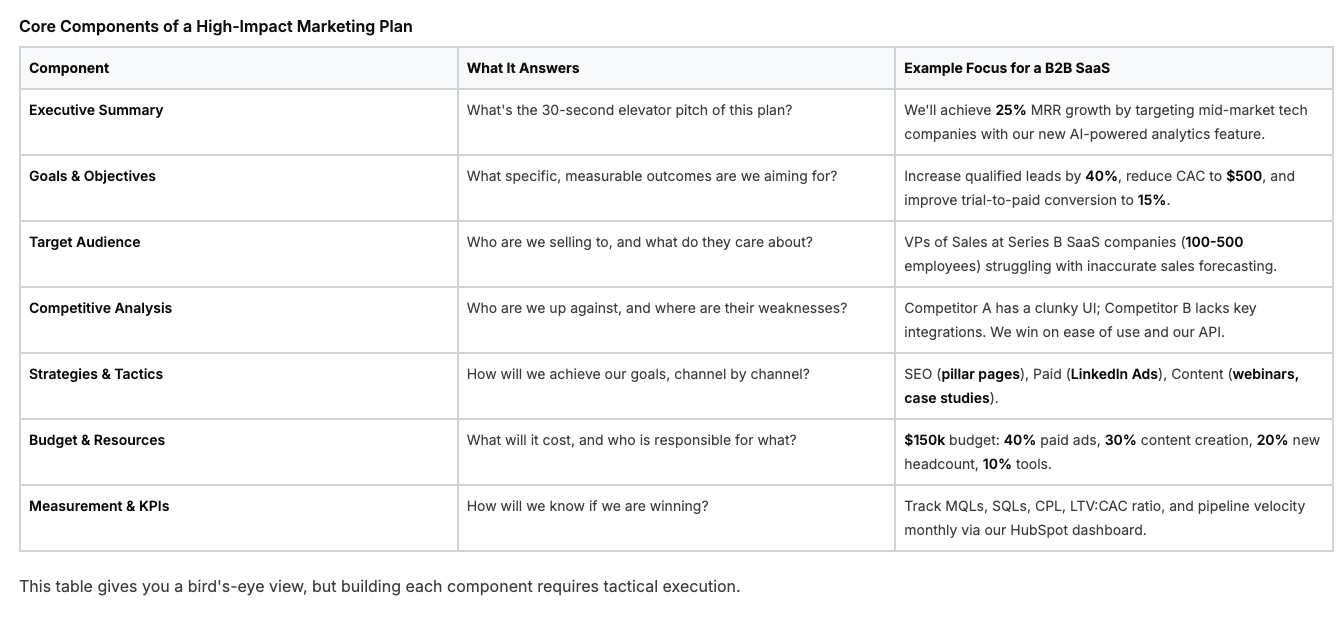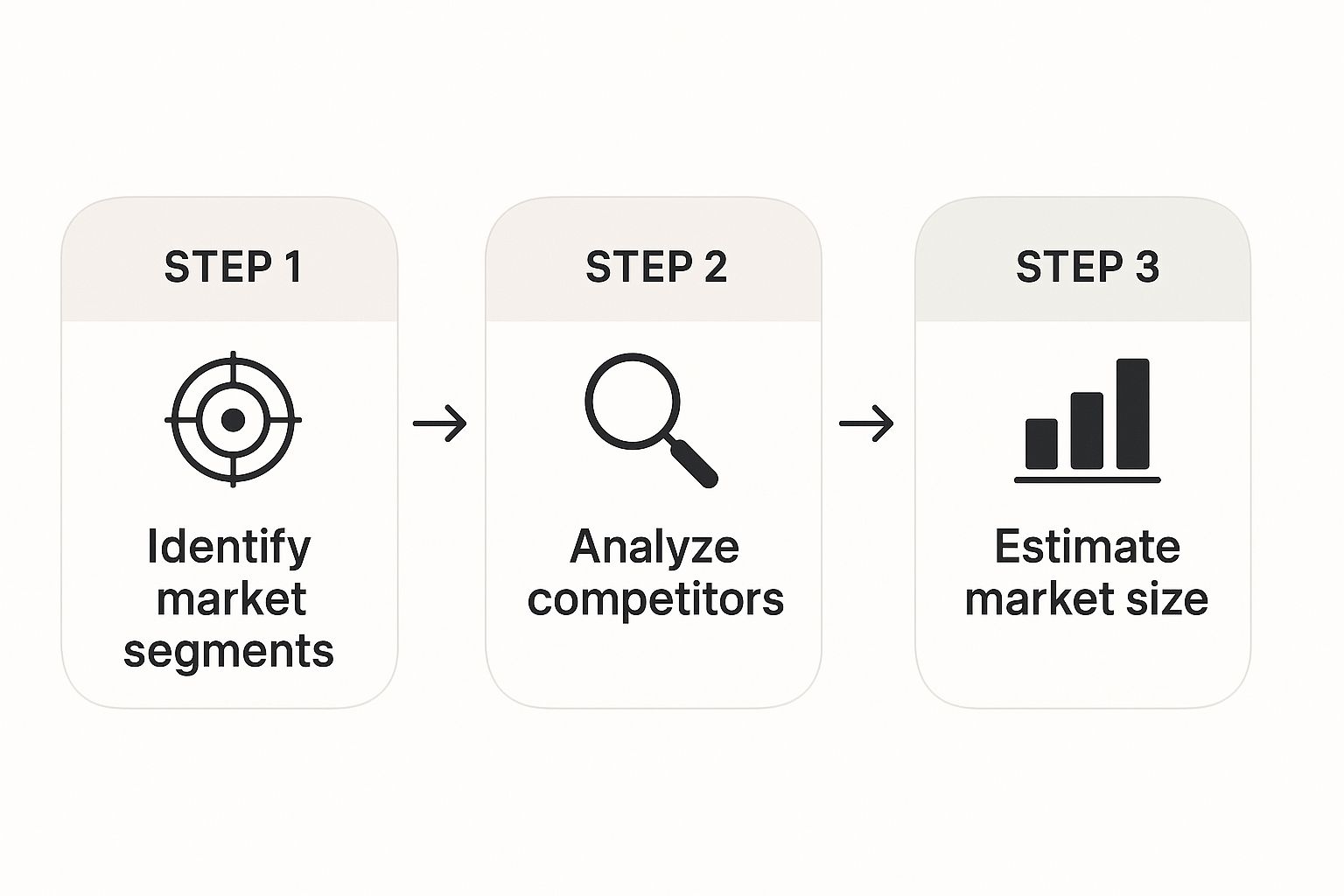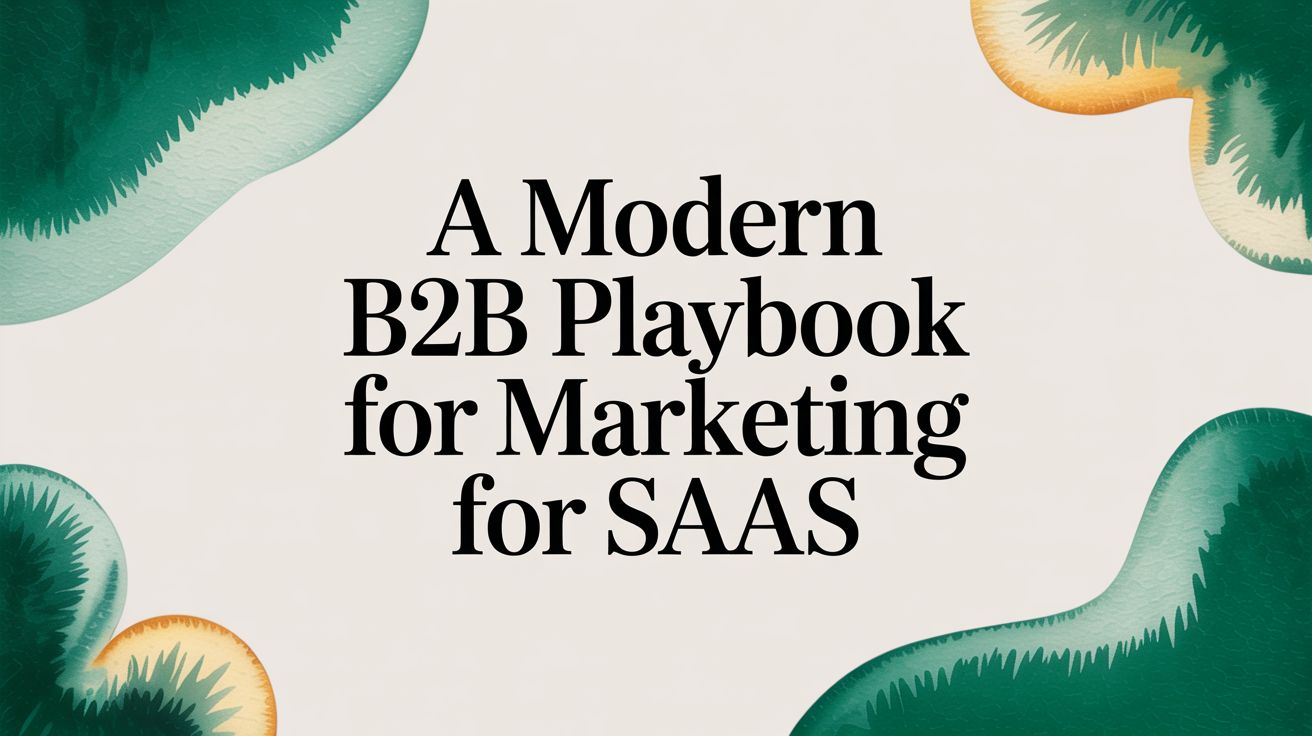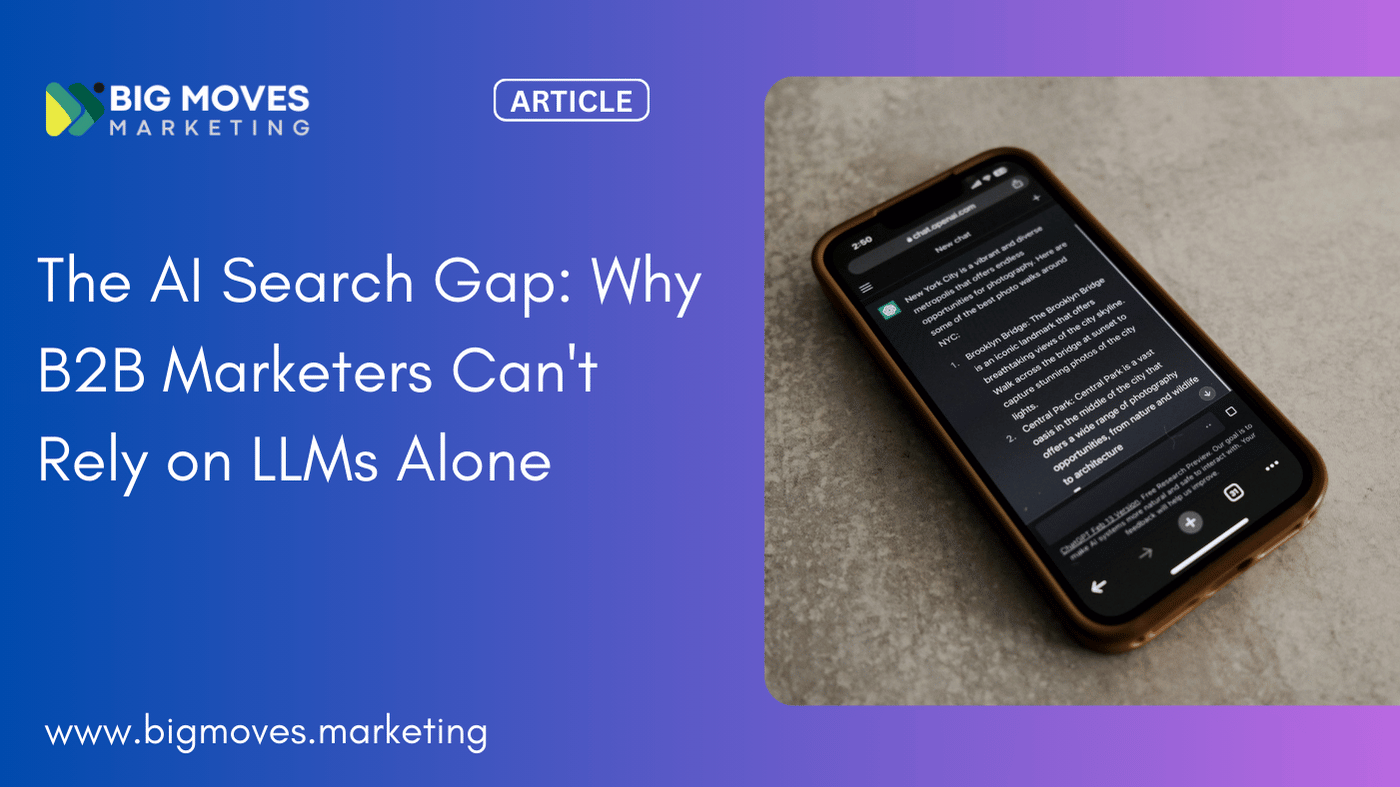How to Write a Marketing Plan That Boosts Growth
August 5, 2025

Think of the last marketing plan you wrote. Did it end up in a dusty binder on a shelf, or worse, as a forgotten file in a shared drive? If so, you’re not alone. But a modern marketing plan isn't a static document; it's a living, breathing blueprint for growth—your company's strategic story.
This is the single most important tool you have for aligning your team, securing the budget you desperately need, and turning ambitious goals into results you can actually measure.

We're not just listing tactics or channels here. We're building a cohesive narrative that connects your company’s core mission to real, tangible market opportunities. A great plan inspires your team to do their best work, shows leadership exactly where their money is going, and delivers results you can proudly report on.
A well-crafted plan is the switch that flips you from reactive, "fire-fighting" marketing to proactive, strategic execution. It’s the difference between being busy and being effective.
Why Your Plan Is More Than Just a Document
Let’s be clear: your marketing plan is the foundational architecture for your entire growth engine. It’s where you make deliberate, sometimes tough, choices about where to invest your time, money, and creative energy.
A documented strategy isn't just a "nice-to-have." It’s a proven performance driver. In fact, research shows that firms with a formal marketing strategy can achieve up to 30% higher sales growth compared to those flying by the seat of their pants.
A powerful plan brings a few key things to the table:
- Clarity and Focus: It forces you to define what success actually looks like and how you'll get there, preventing wasted effort on shiny objects and mismatched initiatives.
- Team Alignment: It ensures everyone—from marketing and sales to product and the C-suite—is rowing in the same direction with a shared understanding of the objectives.
- Budget Justification: It provides a clear, logical rationale for your budget requests, linking every dollar you want to spend to a specific, measurable outcome.
Before you start writing, it’s helpful to understand the core pillars that hold up a high-impact plan. This isn't an exhaustive list, but it covers the non-negotiables.
Core Components of a High-Impact Marketing Plan

This table gives you a bird's-eye view, but building each component requires tactical execution.
Your blueprint for growth often starts with structuring your digital efforts, and a solid website content planning template can be a great place to begin. Ultimately, learning how to write an effective marketing plan is one of the most vital skills for sustainable success. As you build your strategy, remember to also keep an eye on the bigger picture of B2B SaaS growth in 2025 with key lessons for startups.
2. Laying the Groundwork with Solid Data and Insights
Every great marketing plan starts with a dose of reality. Before you even think about setting goals or picking channels, you have to do your homework. This isn't about guesswork; it's about digging in and gathering the intelligence that will shape every strategic choice you make.
Think of it as drawing the map before you start the expedition. Without this foundational data, you’re just flying blind, guided by assumptions instead of facts. A solid foundation ensures your plan is built on the real world, not just wishful thinking. This process starts by looking in the mirror, then looking out the window at your market.
A Modern SWOT for B2B SaaS
The classic SWOT analysis (Strengths, Weaknesses, Opportunities, Threats) is a staple for a reason, but for a B2B SaaS company, it needs a sharper, more specific focus. Forget generic points like "strong team" or "economic uncertainty." It's time to get granular.
- Strengths: What’s our undeniable product advantage? Is it a key integration nobody else offers? Maybe it's a UI so intuitive it slashes onboarding time by 50%. These are the tangible assets you can build on.
- Weaknesses: Where does our product stumble? You have to be brutally honest here. Is there a critical feature gap everyone asks for? Is our pricing model a nightmare for the enterprise clients we want to attract?
- Opportunities: What market shifts can we ride like a wave? Is a new compliance regulation creating a sudden need for our solution? Is a major competitor sunsetting a product, leaving a trail of unhappy customers looking for a new home?
- Threats: What external forces could throw a wrench in our plans? Could a new open-source tool completely disrupt our value proposition? Are bigger, better-funded players starting to sniff around our niche?
This kind of deep dive gives you a clear-eyed view of where you stand. It's the raw material for your strategy, showing you exactly where to press your advantages and where to build up your defenses.
Deconstructing Your Competitors' Playbook
Understanding your competition means more than just knowing their names. You need to become a student of their marketing. The goal is to spot their patterns, reverse-engineer their playbook, and find the gaps they’ve left wide open for you.
A crucial part of building your foundation is getting to know the competitive landscape inside and out. You can get a much deeper tactical guide by reading up on how to analyze competitors. This isn't about copying them; it's about learning from their wins and their stumbles to sharpen your own attack plan.
Don’t just look at what your competitors do; dig deeper to understand why they do it. If they're pouring money into webinars, it's a strong signal that channel converts for them. That’s a powerful clue for your own strategy.
For a complete guide to gathering the data you need, check out our full guide to effective B2B market research to really flesh out this foundational step.
This visual shows a simplified flow for how to think about your initial market assessment.

As you can see, identifying your target segments naturally flows into analyzing the competitors who are already talking to them. This, in turn, helps you realistically size up the market opportunity.
Defining Exactly Who You're Selling To
This might be the most critical piece of the puzzle. If you don't have a razor-sharp definition of your audience, your marketing messages will be generic, unfocused, and frankly, ignored. You need to move from a vague idea of "our customer" to a concrete, living profile.
Start with your Ideal Customer Profile (ICP). This is a firmographic description of the company that gets the most value from your product—and in turn, provides the most value to your business.
Example ICP for a Project Management SaaS:
- Industry: Marketing Agencies
- Company Size: 20-100 employees
- Geography: North America
- Pain Point: Constantly struggles with managing client projects, leading to missed deadlines and scope creep that kills profitability.
- Tech Stack: Already uses Slack, Google Workspace, and HubSpot.
With your ICP locked in, you can drill down to develop buyer personas. These are semi-fictional profiles of the actual people inside those ideal companies who influence or make the buying decision. Get inside their heads and focus on their specific roles, goals, and daily frustrations.

With this foundation of data—your honest SWOT, your competitive intel, and your crystal-clear audience definitions—you're no longer guessing. You're ready to build a marketing plan that is targeted, relevant, and built to win.
Setting Goals That Inspire Action and Drive Results

Ambiguous goals will always lead to ambiguous results. After you’ve laid the groundwork with solid data, it’s time to turn your ambitions into concrete objectives that actually galvanize your team. This is where you give every marketing dollar a clear purpose and your plan gets its heartbeat.
Goals are far more than just numbers on a slide; they are the North Star for your entire team. They bring clarity and focus, creating a shared definition of what winning looks like. Without them, your marketing efforts risk becoming a series of disconnected activities instead of a cohesive engine for growth.
Go Beyond Vague Ambitions
Things like "increase brand awareness" or "get more leads" aren't goals; they're wishes. To drive real performance, your objectives have to be specific, measurable, and tied directly to what the business actually cares about. This is where the classic SMART framework becomes incredibly powerful, especially for a B2B SaaS company.
Let's translate some of those fuzzy ideas into powerful, actionable targets:
- Instead of: "Get more leads."
- Try: "Increase Marketing Qualified Leads (MQLs) from organic search by 25% in Q3, from 200 to 250."
- Instead of: "Improve our conversion rate."
- Try: "Achieve a 15% conversion rate from demo request to paid subscription within six months for our enterprise tier."
These examples provide immediate clarity. Everyone knows exactly what they’re working toward, how it will be measured, and when it needs to happen. This is the level of specificity that turns a marketing plan into an operational roadmap.
Your goals shouldn't just track activity; they must track progress. A great objective tells a story of where you are, where you want to go, and how you'll know when you've arrived.
Connecting Marketing Objectives to Business Revenue
The most persuasive marketing plans are the ones that draw a straight line from marketing activities to the company's bottom line. Your CEO and CFO care about revenue growth, customer acquisition cost (CAC), and customer lifetime value (LTV). Your marketing goals must speak their language.
This alignment is critical for securing budget and earning enthusiastic buy-in from leadership. To make sure your goals hit the mark, it's vital to define the key digital marketing performance metrics you’ll track. Show them precisely how your work impacts the numbers they care about most.
Here’s how to frame it:

This approach demonstrates clear ROI. It shifts the entire conversation from "we need more money for ads" to "this investment will generate X amount of pipeline and contribute Y to our revenue target."
Thinking this way ensures your marketing plan isn't just a departmental document but a core piece of the company's growth strategy. It shows you understand the mechanics of the business and are focused on delivering tangible value. For more insights on this topic, our guide on achieving digital growth in B2B marketing offers additional strategies.
With clear, revenue-focused goals, you're ready to build a strategy that truly delivers.
With your data-backed goals set, it's time to get into the heart and soul of your marketing plan. This is where we move past the numbers and into the narrative—shaping the core idea that will guide every piece of content, every ad, and every sales conversation.
This isn't about listing tactics. It's about defining the central, guiding principle for how you communicate. We're building a message so clear and compelling that your ideal customers don't just understand it; they feel like you've read their minds.
Nailing Your Brand Positioning
Think of brand positioning as your stake in the ground. It's a sharp, internal statement that declares exactly who you serve, what you do for them, and why you’re the only real choice. This is the strategic bedrock for all your external messaging, ensuring everyone on your team is singing from the same hymn sheet.
A solid positioning statement is more than just marketing fluff; it's a tool for company-wide alignment. It tells your product team which features matter most, helps your sales team frame discovery calls, and gives your marketing team the stories they need to tell.
Here’s a simple but incredibly effective framework to build from:
For [Target Customer] who [has this specific pain point], [Your Company] is the [Category] that provides [this key benefit]. Unlike [Primary Competitor or the status quo], we [are this unique differentiator].
Let’s bring this to life. Imagine a B2B SaaS company with an AI-powered tool for contract reviews.
Example Positioning Statement:
"For legal teams at fast-growing tech companies who are buried in manual contract reviews, LegalFlow is the AI-powered platform that slashes review cycles by 90%. Unlike clunky legacy software or the tedious manual process, our tool offers seamless integrations and an intuitive UI that delivers actionable insights in minutes."
See how specific that is? It's benefit-driven and immediately carves out a competitive edge. This statement becomes the compass for every piece of messaging you create.
From Positioning to a Powerful Value Proposition
While positioning is your internal North Star, your value proposition is the external promise you make to customers. It’s the single most important reason a prospect should choose you, and it needs to hit them right between the eyes.
A great value proposition instantly answers three questions for a visitor:
- Is this for me? (Relevancy)
- What’s in it for me? (Quantified Value)
- Why you? (Unique Differentiation)
This should be the first thing anyone sees on your homepage. It’s not a catchy tagline. It's a direct promise of value delivered.
A strong value proposition doesn’t sell features; it sells outcomes. It focuses on the customer’s transformed state after using your product—less time wasted, more revenue gained, or fewer critical errors.
The Real Differentiator: Authentic Storytelling
In a B2B SaaS market flooded with similar-sounding features, your story is the ultimate differentiator. Authentic storytelling is how you weave your company’s mission and values into your marketing, building genuine trust and connection that goes beyond a feature list.
This is where you move beyond what your product does and start sharing why your company even exists. Tell the origin story—what problem were you completely obsessed with solving? Showcase real customer journeys, highlighting their struggles and how you helped them achieve their wins.
This human-centric approach is no longer a "nice-to-have." As markets get more crowded and complex, genuine storytelling is critical. In fact, one report on global marketing predictions for 2025 suggests that by 2025, successful strategies will hinge on personal employee and customer stories to bridge cultural divides and meet the growing demand for authenticity.
Don't just state your values—demonstrate them. If you value customer success, publish incredibly detailed case studies. If you prize innovation, offer behind-the-scenes glimpses into your product development. This is the narrative fabric that turns casual browsers into passionate brand advocates.
Choosing Your Channels and High-Impact Tactics

Alright, you've got a solid strategy and your goals are crystal clear. Now for the fun part: making it all happen. This is where the plan stops being a document and starts becoming a real-world, lead-generating machine.
Picking the right marketing channels isn't about jumping on every new trend. It's about making smart, deliberate bets on where your ideal customers actually live and breathe online. For a B2B SaaS company, that means creating a multi-channel engine where every part works together, creating a smooth path that turns curious prospects into die-hard fans.
Let's dive into the high-impact plays that will actually move the needle.
Build a Powerful Content Marketing Engine
Think of content as the fuel for everything else you do. It’s what gets you found on Google, gives your social media a pulse, powers your email campaigns, and, most importantly, cements your team as the go-to experts in your space.
The secret is to stop thinking in terms of "random acts of content" and start building a strategic engine. Your content plan should be a direct answer to your buyer's biggest questions and frustrations at every stage of their journey.
- Top of Funnel (Awareness): This is about broad appeal. Think insightful blog posts, shareable short-form videos, or comprehensive industry reports. A project management tool, for example, might publish an article on "The True Cost of Inefficient Agency Workflows."
- Middle of Funnel (Consideration): Go deeper. This is where you offer gated content that solves a very specific problem. We're talking detailed whitepapers, compelling case studies, or live webinars that show off your solution's value without a heavy sales pitch.
- Bottom of Funnel (Decision): Make the choice easy. High-intent assets like pricing guides, competitor comparison pages, and detailed customer success stories are your best friends here.
Remember, your blog isn't just a place to stuff keywords for Google. It's a living library of assets your sales team can grab to answer questions, handle objections, and ultimately, close deals faster.
Capture High-Intent Traffic with SEO
Search Engine Optimization (SEO) is your long game. It’s an investment in sustainable, organic growth that pays dividends for years. When a prospect types a problem that your software solves into Google, you absolutely have to be there.
For B2B SaaS, this means homing in on keywords that signal a strong intent to buy. Don't just chase a massive-volume term like "project management software." Get specific. Get problem-oriented.
A prospect searching for "best project management tool for marketing agencies" or "how to integrate Slack with a client portal" is much, much closer to making a purchase. Your entire SEO strategy should revolve around answering these high-value, specific questions.
Establish Authority on LinkedIn
For anyone in B2B, LinkedIn is simply non-negotiable. It's not just a digital resume holder or a place to post company news. It's the platform for building genuine authority, connecting directly with your ideal customers, and starting conversations that lead to real business.
An effective LinkedIn strategy is a mix of smart company page content and, crucially, empowering your people to build their own personal brands. Encourage your execs, product leaders, and salespeople to share what they know. That human-to-human connection builds a level of trust that a faceless corporate logo never will.
Getting your teams aligned is key to making this work. If you want to dig deeper, check out our insights on creating powerful alignment between sales and marketing in B2B.
Implement Targeted Paid Advertising
Paid ads give you a direct line to your ideal customer, with incredible precision and speed. While Google Ads certainly have their place, LinkedIn Ads are often the B2B SaaS marketer's secret weapon. You can target people by job title, company size, industry—even by a specific list of target companies.
But please, don't just run ads that point to your homepage. That's a surefire way to burn cash. Instead, create targeted campaigns that promote your most valuable content, like a webinar or a new whitepaper. This approach generates leads while providing real value from the get-go, starting the relationship on the right foot.
It's also crucial to see how trust is shifting. Old-school ads are losing ground. Today’s data shows that 76% of social media users say content on these platforms influences their purchases. And in response, 59% of marketers are planning to increase their use of influencer partnerships. This signals a clear move toward more authentic, trust-based marketing. Your plan needs to reflect this reality by outlining how you’ll find and collaborate with the influential voices in your niche. You can find more on these changing dynamics in these digital marketing statistics and trends on Marketing Dive.
Common Questions About Writing a Marketing Plan
Even with the best guide in hand, a few questions always pop up when you're in the thick of building a marketing plan. Let's walk through some of the most common ones I hear from B2B SaaS marketers so you can move forward with total clarity.
How Often Should I Update My Marketing Plan?
Think of your marketing plan as a living, breathing document—not a "set it and forget it" file that gathers digital dust. It's your strategic guide, and it needs to evolve right alongside your business.
For most B2B SaaS companies, a quarterly review hits the sweet spot. This rhythm is frequent enough to let you check progress against your KPIs and make smart adjustments based on what the data is telling you, without getting bogged down in constant planning.
You'll also want to schedule a more comprehensive overhaul once a year. This annual ritual is your chance to zoom out, set new high-level goals for the year ahead, and shift your budget based on a full 12 months of hard-won lessons. For fast-growing startups, even quick monthly check-ins on specific tactics can be a game-changer.
What Is the Biggest Mistake to Avoid?
The absolute biggest mistake you can make is writing your marketing plan in a silo. It’s a classic trap. The marketing team locks themselves away, works for weeks, and emerges with a "master plan" that's completely disconnected from the rest of the business.
When this happens, the plan is almost guaranteed to fail.
A plan created in isolation will never truly align with sales quotas. It won't reflect the product team's upcoming roadmap. And it certainly won't address the real-time feedback your customer success team hears every single day.
True strategic alignment is born from collaboration. When you bring sales, product, and success teams into the process from the start, you get company-wide buy-in and build a cohesive growth engine everyone feels a part of.
How Do I Create a Marketing Budget?
If you're staring at a blank spreadsheet wondering what things cost, the best way to start is by working backward from your goals.
For example, if your objective is to generate 200 Sales Qualified Leads (SQLs) this quarter, start researching. What's the average cost-per-SQL in your niche for key channels like LinkedIn Ads or targeted content syndication? Use industry benchmarks as your starting point.
Another tried-and-true approach is to base your budget on a percentage of your company's projected annual revenue. For most B2B SaaS businesses, this number falls somewhere between 5-12%.
Start with educated estimates, but always build in a contingency fund of 10-15%. You'll need it for testing new channels and jumping on unexpected opportunities. From there, be ready to reallocate spending as you gather real performance data. Tracking your spend against results is non-negotiable, and knowing how to measure marketing success is fundamental to justifying—and optimizing—your budget over time.
At Big Moves Marketing, we specialize in transforming ambitious goals into actionable, data-driven marketing plans that deliver measurable results for B2B SaaS startups. If you need expert guidance to build a strategy that accelerates your growth, let's connect. Learn more at https://bigmoves.marketing.
%20-%20Alternate.svg)


%20-%20white.svg)